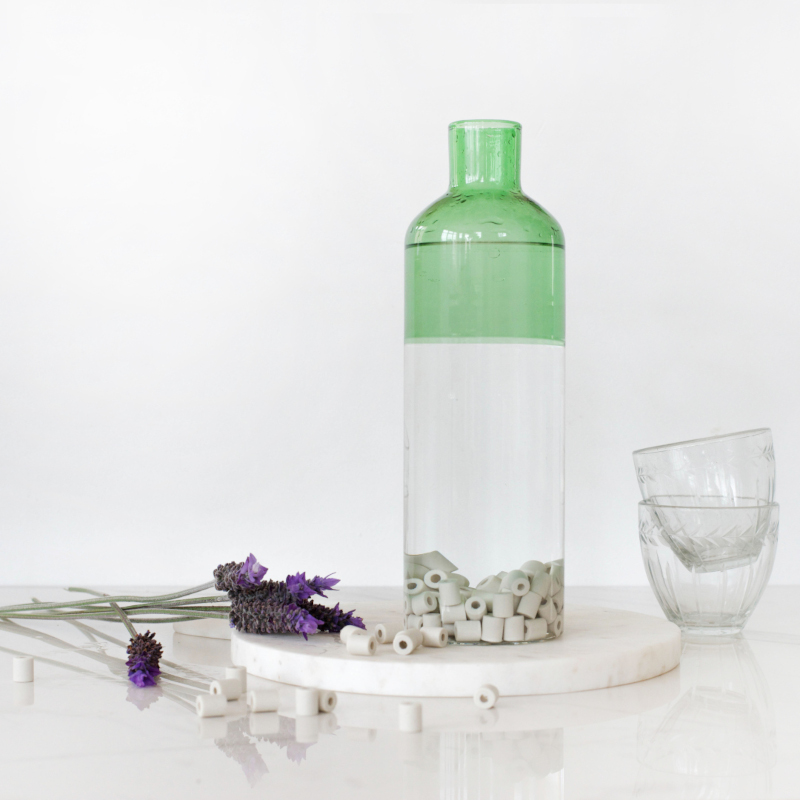
If you don't already have them in your water jug or flask, you've probably already heard about them. From a friend, a family member or your local grocer. Why am I so sure? Because ceramic beads are an ecological, economical and sustainable solution which, among other things, considerably reduces the consumption of water in particularly polluting plastic bottles.
But, like any new product, this eco-responsible alternative raises many questions about its action, its effectiveness, its origin, its interest compared to other more widespread solutions such as binchotan coal, and many other related questions.
As a pioneer in the distribution of ceramic beads for nearly 20 years, Chamarrel® shares its experience and that of its users by providing a substantiated answer to your most frequently asked questions about EM ceramic beads.
This will not have the impact of the user experience, obviously (and unfortunately), but it will have the merit of clearing up some doubts, of nourishing your opinion somewhat, or of making the best use of the ceramic beads that you already have in your possession.
EM CERAMIC BEADS, WHAT ARE WE TALKING ABOUT?
Why is their name on everyone's lips and their presence in every carafe? Knowing more about EM ceramic beads helps us to understand the recent craze that they have aroused, despite the scepticism of some.
1. What are EM ceramic beads?
Ceramic is nothing more or less than clay fired at very high temperatures. Ceramic beads are therefore made of clay fired between 800°C and 1200°C.
But it's not just ceramic.
What does "EM" mean? EM stands for "Effective Micro-organisms".
In short, EM ceramic beads are small tubes of clay made up of useful and beneficial micro-organisms found in nature and which are not manipulated. Microorganisms play an essential role in ecological cycles. They stimulate life by increasing the population of beneficial micro-organisms.
2. What is the action of ceramic beads?
The person who developed the EM technology, Japanese Professor Teruo Higa, obviously says it best. He explains that EM ceramic beads, by magnetic resonance, have a regenerative and antioxidant power.
The EM ceramic beads eliminate harmful information from the water. One of the properties of ceramics is that they cause ion exchange and long-wave infrared radiation, which erases the information transmitted by the water molecules and restores the original clean state.
Ceramic beads also have a preventive and curative effect on oxidation.
Each ceramic bead is a medium for the diffusion of EM information contained in the fired clay, which can then be retransmitted to the substances in contact.
3. Where do ceramic beads work?
Ceramic beads are active in water, but not only in water.
Micro-organisms are active in the air, in the soil and in the water. Wherever they abound, they clean up and remove pathogens.
This process benefits plants, and thus the health of animals and people.
4. What is the benefit of ceramic beads in two words?
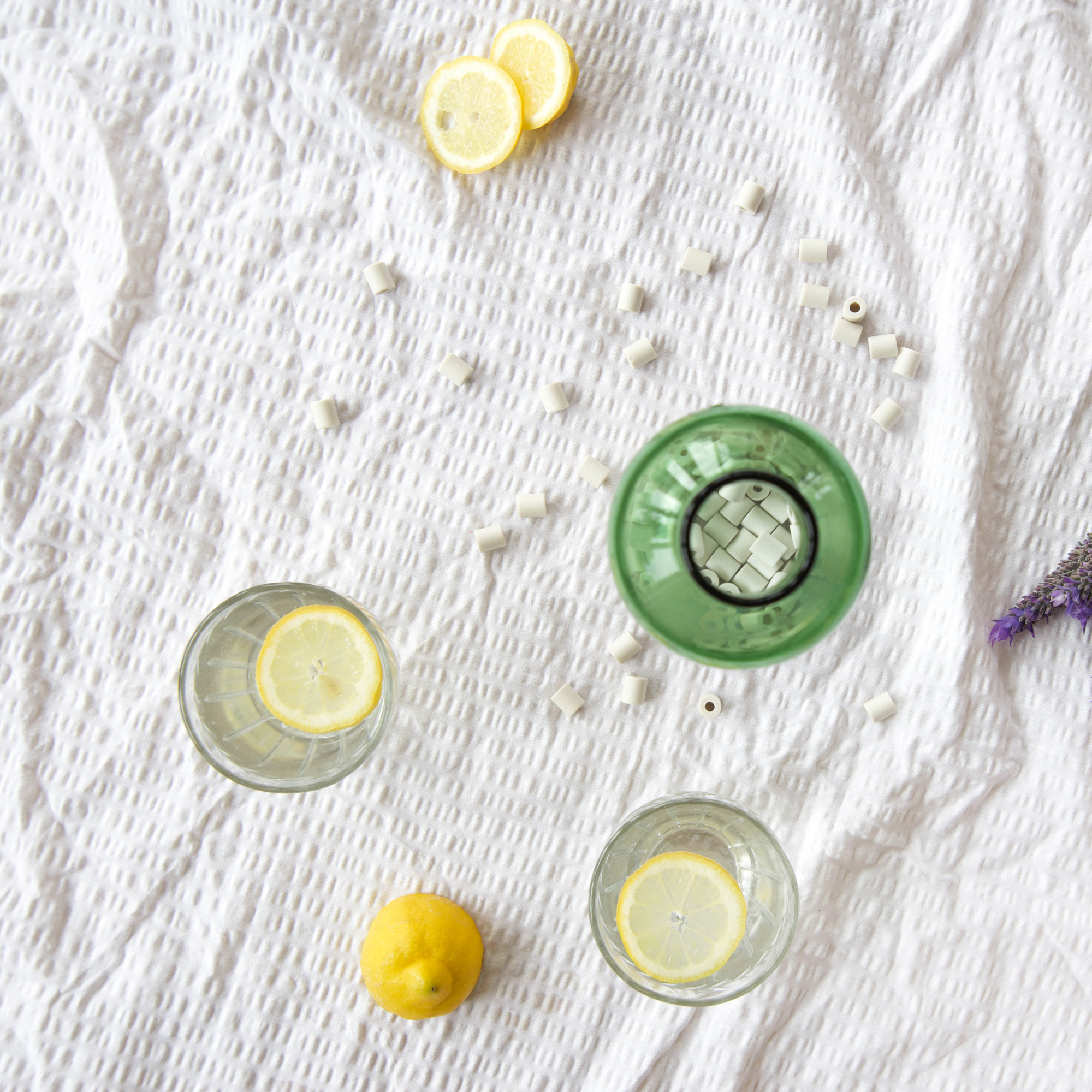
Ceramic beads have a definite ecological interest and are synonymous with savings.
Indeed, they encourage and promote the consumption of tap water.
Drinkable and of good quality in France, tap water, although less expensive, is sometimes shunned by children and adults alike because of its taste, which is considered unpleasant depending on the region and the sensations of each person. Ceramic beads improve the quality and taste of the water, making it pleasant to drink, and at no extra cost.
In addition, their exceptional durability of over 10 years for grey ceramic beads makes them a very inexpensive and cost-effective purchase. No need to buy plastic water bottles anymore, this is a substantial saving and also a strong act and a contribution that counts in the fight against plastic pollution.
In addition to their exceptional lifespan, the ceramic beads (being 100% natural) are compostable. Place them directly in the soil or in your compost.
5. Where are the ceramic beads made?
Ceramic beads are made where the EM technology was developed, in Japan. Chamarrel® tells you this transparently, although some retailers confuse the issue by highlighting that their company or brand is French, leading the harried, distracted or idealistic reader to believe that the ceramic beads are made in France. This is not the case.
Be careful, you will notice that somewhere on the website of those who forget to specify the Japanese origin of the ceramic beads often appears, in a more or less visible way, the mention "Authorized reseller". They are therefore French resellers of a Japanese product, and not manufacturers.
Do not be naive. Chamarrel® states that this process is the work of Japanese Professor Teruo Higa and is based on his own experience as a user and as a retailer thanks to the numerous feedbacks from his customers over the past two decades.
If someone assures you that the ceramic beads are made in France, be all the more vigilant, and remember that successful products are often counterfeit.
6. Are ceramic beads from Japan radioactive?
Chamarrel® uses the services of an independent French laboratory which carries out radioactivity tests and certifies that the ceramic beads are not radioactive. Chamarrel® makes available to its customers, on request, the report of the analysis of the aforementioned laboratory written by a doctor in geochemistry.
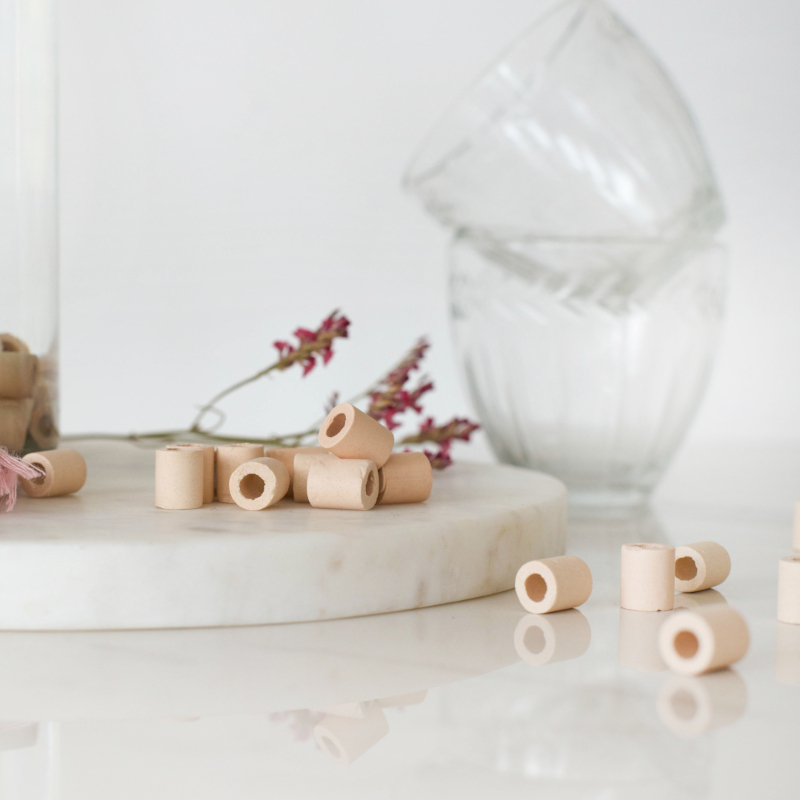
7. What are the two major variations of ceramic beads?
We are talking about two major families of EM ceramic beads. The grey (or white) ceramic beads and the pink ceramic beads.
They are actually the same process. They simply have a difference in colour and texture due to their different firing temperatures.
Fired at 1200°C the clay of ceramic beads becomes light grey (or white) and very solid. Whereas the clay in EM ceramics fired at 800°C is pink, more porous and fragile.
This will obviously have a slight impact on the properties and use of each of these categories of ceramic beads.
8. What is the difference between grey and pink ceramic beads?
Grey ceramic beads have a different action from a mechanical filter. They improve the molecular structure of the water and make it more dynamic. This allows the water to regain its natural purifying power. It is thus better able to remove harmful substances from the water rather than deposit them (both in jugs, appliances and the body).
The Larousse dictionary defines "adsorption" as follows: "Phenomenon by which powdery or porous solids or solutions retain molecules or ions on their surface in the gas or liquid phase". Pink ceramic beads are therefore ideal for retaining harmful substances in water.
Grey and pink pearls can be used separately or mixed in decanters.
The grey ones are sufficient to improve the taste and texture of your water and last for many years. If you also want to improve the quality (composition) of your water, opt for the pink ones, which should be changed every 6 months or so.
If you don't like the taste of the pink pearls, combine grey and pink pearls. Test and adjust the dosage according to your needs and sensations.
9. How to choose your ceramic beads?
The choice of ceramic beads varies according to the use, the quantity of water, the quality of your tap water, and even your personal preferences.
To find out which ceramic beads you need, you should first ask yourself what you want to use them for. You will immediately see more clearly
10. How do I care for ceramic beads?
Ceramic beads do not require any particular or tedious maintenance. However, to ensure that they are as effective as possible, Chamarrel® recommends that you immerse them in boiling water for 10 minutes and then leave them to dry. This can be done once a month or so, or when you feel that the effect of the ceramic beads is less noticeable.
You can also gently scrub them with a small brush or loofah if you wish.
11. Why use ceramic beads in household appliances?
Do you know what limescale is? It forms deposits due to the presence of limescale in tap water, in greater or lesser quantities depending on the region.
When limescale deposits in the pipes of your household appliances or on the electrical resistances, its effects are damaging.
Not only does it clog and block, but it will also increase electricity consumption and reduce the effectiveness of the detergents and washing powder used. You will notice white marks or rougher laundry, and you may compensate with extra detergents.
The EM ceramic beads reduce limescale deposits considerably thanks to their action on the water molecules. The result is quickly visible to the naked eye, especially in coffee pots and kettles. The same process is used in washing machines and dishwashers, saving you time, energy and cleaning products.
12. Ceramic beads or binchotan charcoal: which is more effective?
Let's face it, ceramic beads and binchotan charcoal are not opposites. They obviously have some points in common and some notable differences. But to pit them against each other would be to ask which is more effective, the hammer or the screwdriver. In reality, they are often used on the same sites and their effectiveness simply depends on the use you decide to make of them.
Ceramic beads and binchotan coal are complementary, and the principle of synergy whereby 1+1=3 applies to them. For example, their use to obtain pleasant tap water can be done separately, but used together, ceramic beads and binchotan charcoal act respectively and simultaneously on the water molecules and on its filtration, for a very satisfactory and optimal result.
We could compare the two solutions, but that is not the purpose of this article.
13. Is the effectiveness of ceramic beads scientifically proven?
Obviously, the action of EM ceramic beads and their effectiveness are supported by scientific studies mainly written in Japanese (Professor Teruo Higa's language) and in English. In addition to the technical nature of the process, the fact that the studies are written in these languages partly explains the lack of knowledge in France of Professor Higa's work and consequently the scepticism of some people.
Whether they are unanimously accepted or not, the fact remains that the invisible action of ceramic beads on molecules is very perceptible when used, which explains their success with those who have tried them.
It is a fact that the empirical approach sometimes prevails over theory.
Science examines living things with great curiosity and tries to explain them with great skill. However, it recognises simple phenomena that it does not fully support or explain, such as the "open air factor", i.e. the impact of the open air effect, which causes pathogens to be destroyed in the open air. This is why it is recommended to regularly air the home with outdoor air. The sun and the open air are natural disinfectants and are likely to have an impact on our well-being and morale.
Everyone has their own approach. One can stay at home and wait to understand this reality or go out and enjoy all its benefits.
Is the use of plastic water bottles unanimously accepted? Doesn't it have a catastrophic environmental impact? Isn't it expensive? Scientific studies have repeatedly pointed the finger at the consumption of plastic bottled water and its abuses.
Scientific evidence is often put forward as an argument to question certain initiatives that go off the beaten track. But the positive ecological impact of ceramic beads is undeniable and known far beyond our French borders.
And if science is presented as universal, it is essential to remember that it takes the form of diverse, sometimes contradictory and often controversial studies.
"Some people are only affirmative in denial", said Robert Sabatier, and this is their strictest right. But we can affirm it by experience, as far as ceramic beads are concerned, scepticism hardly resists experimentation.
14. How can ceramic beads be used?
Among the various possible containers for ceramic beads, we can mention the following in no particular order: carafes, gourds and kettles, dishwashers and washing machines, bathtubs, vases, watering cans, rinsing water for fruit and vegetables, and aquariums.
They are even useful as collars for dogs and cats. You will discover below the interest of using ceramic beads in these different uses and the precise information concerning their dosage.
15. Can ceramic beads make water drinkable?
No. This is not their purpose. Ceramic beads should only be used in drinking water if you intend to consume it. They can be used with non-potable water for various purposes, but they will not make the water drinkable.
GREY CERAMIC BEADS: STAR OF THE EM ?
16. What is the impact of grey ceramic beads in water?
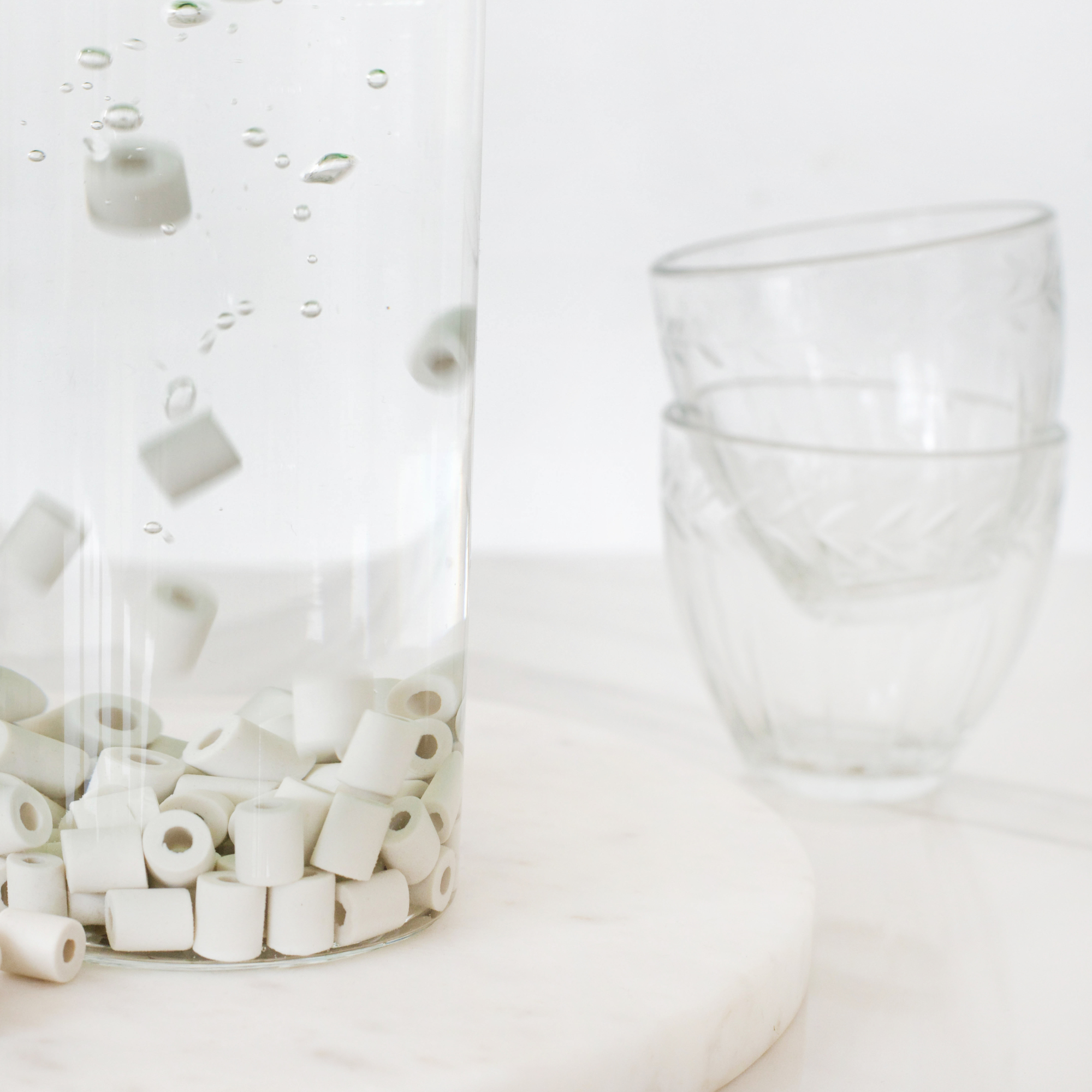
Fired at 1200° C, the clay fermented with a cocktail of about 80 micro-organisms that makes up the grey ceramic beads is safe because the micro-organisms are dead.
But the clay serves as a colloid, it is a catalyst. It captures the information of the micro-organisms, their radiation, their frequency. And it is this frequency that will be restored when the ceramic beads are immersed in water.
The grey ceramic beads do not have a filtering action like a mechanical filter would have. They act at the level of the water molecules. The radiation (frequency) contained in the clay will break up the clusters of water molecules that have formed between the time the water was pumped from the source, passed through the pipes and reached the tap.
As a result of its journey, the water is very far from its original state. It has naturally picked up all sorts of things and can become loaded with lead or iron, especially if the pipes in buildings are old.
In addition, nitrates (permitted at 50 mg per litre), pesticides, aluminium sulphates and chlorine used to sanitise the water are sometimes found. The molecules are clumped together.
The ceramic beads will break up these molecules, dissociating them. As a result, the water regains its original power, washing, cleaning, rinsing, its intrinsic properties. At the same time, this will reduce the surface tension of the water. The result is lighter, softer, more refreshing water.
In appliances, it washes better, rinses better, and therefore requires less detergent to have the same action. Since they release the water molecules from what they have picked up since their transfer, this will also reduce limescale deposits. The taste and smell of the water is also greatly improved.
In short, ceramic beads remove all impurities from the water, not by capturing them, but by allowing the water itself to eliminate them.
17. How long do grey ceramic beads last? Ceramic beads - durable and environmentally friendly. Exceptional durability.
The durability of grey ceramic beads is said to be 10 years or more.
Do we have any practical experience with this claimed lifespan? As a pioneer in the distribution of ceramic beads, Chamarrel® shares with you the feedback of its first-time users.
Look closely at the 2 grey ceramic beads in the middle of the picture.
They are a little rounded, as if eroded by mechanical wear. Why do you think this is?
How old do you think they are? They are 16 years old and still effective.
Note what the owner, Aude, says about them: "Since 2004, I have been using the "grey" ceramic beads for various purposes. Over the years, the beads have lost some of their cylindrical shape, they seem to have eroded and become "rounder". I'm very happy about it, that's why I talked about it around me.
For what purposes did Aude use her ceramic beads and with what results?
She continues:
"For rinsing water for fruit and vegetables and especially to preserve them for longer, without them becoming 'stunted'. For example, I can easily keep my salad for 15 days, wrapped in a cloth with a few pearls, in the fridge, and it stays crunchy, the leaves don't wilt.
In my washing machine, I put the pearls in a net and there is no need to use a fabric softener (which could be allergenic for my daughter's skin). The laundry is not rough, of course.
I also have a pearl necklace in the toilet tank, which prevents limescale build-up in the bowl. I have really seen the difference before and after
And finally, in my water bottle, a jug of water, my kettle and the tank of my coffee machine: the water in [my town] is very hard and many people complain about its taste. With the pearls, I have the impression that its bleach taste is attenuated, if not non-existent."
As you can see, ceramic beads are really very durable, and even if there is a visual difference between new beads (at the ends) and ceramic beads that have been used for 16 years (due to the beads rubbing against each other during use), they have one thing in common, they are still effective!
18. What are the variations of grey ceramic beads?
- Classic beads
Classic ceramic beads are 11 mm long, 9 mm in diameter and weigh 1.4 g.
They are used in particular for water treatment.
The tubular shape and structure of the pearls ensure optimal contact with the water due to their large contact surface.
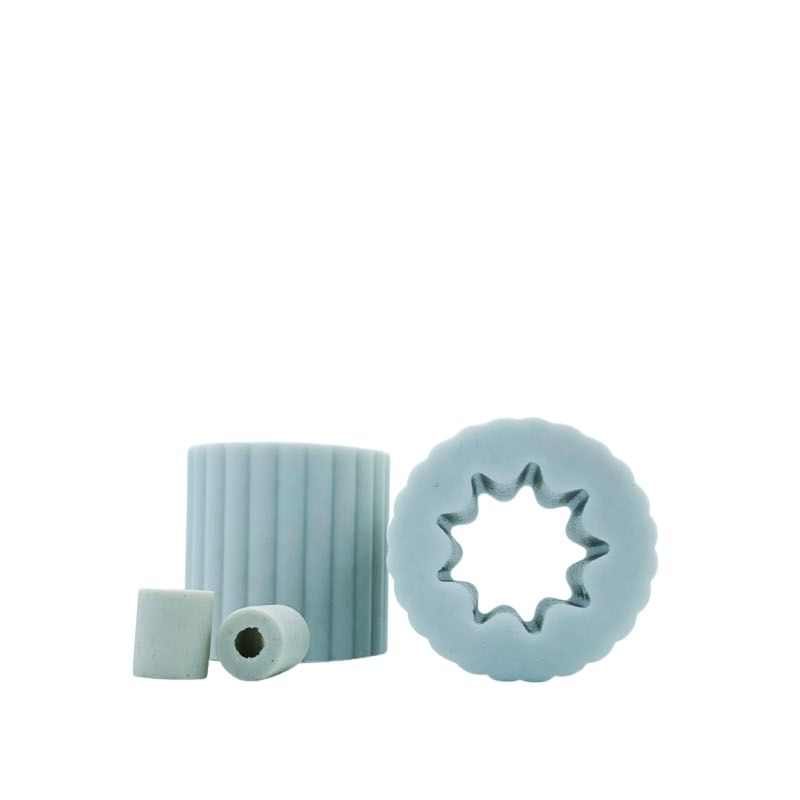
- Ceramic mega-bead
This ceramic bead has the same properties as conventional ceramic beads. Its larger size makes it suitable for large containers and large quantities of water. It weighs 48 grams and has a diameter and length of 35 mm.
- Bath Figure
More attractive and practical with its integrated suction cup attachment, this EM ceramic figurine fits in the bathtub and promotes softer, lighter water. It weighs 73.5 grams, is 80 mm high and 12 mm thick.
- Cooking figure
This special cooking figure has a very high resistance to heat and shocks. It can therefore be used in the kettle, cooking water or frying oil for example. Its weight is 43.5 grams for 40 mm diameter and 20 mm height.
- Pitcher figurine (opposite): A ceramic EM to be used for cold drinks up to 2 litres. The curved shape of this figurine is very aesthetic and easy to use. It weighs 20.5 grams and is 48 mm in diameter and 14 mm high. Practical, it allows you to use a single accessory rather than 15 or 20 classic ceramic beads.
All these variations of grey EM ceramic beads have an unlimited lifespan of more than 10 years, except for mechanical wear.
PINK CERAMIC BEADS: UNKNOWN CERAMIC BEADS?
19. What is the impact of pink ceramic beads in water?
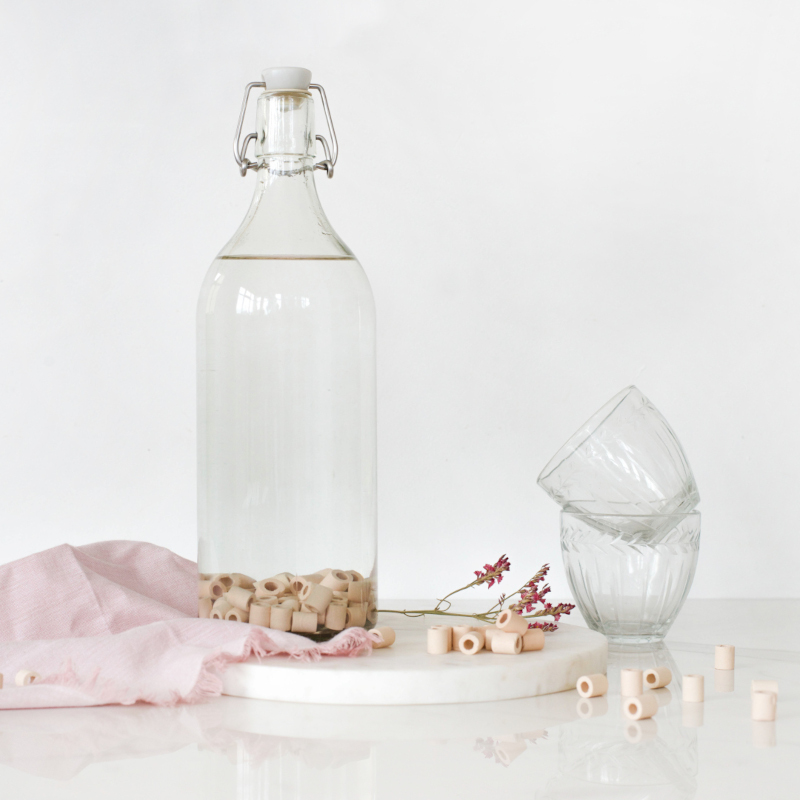
The action of pink ceramic beads is similar to that of the grey beads described above, since they have the same constitution.
However, there is a substantial difference between the two.
Due to its lower firing temperature, the pink ceramic bead is porous, and therefore its multiple microcavities give it adsorption properties. It therefore acts both like ceramic beads and like a Binchotan carbon filter, but with a smaller surface area. Obviously, this adsorption ability has a direct impact on its durability.
20. What is the life span of pink ceramic beads?
Pink ceramic beads have an average life span of 6 to 8 months of daily use.
Why such a big difference with the life span of grey ceramic beads which last more than 10 years?
This is simply due to its filtering properties. Harmful particles attach themselves to the EM ceramic. Once saturated, it is no longer able to filter, and the particles it has previously retained could pollute the water. It should therefore be composted or put directly into the soil after 6-8 months.
21. Can pink ceramic beads be used in the kettle?
Although some people recommend it, Chamarrel®, from experience, advises against it. Pink ceramic beads are more porous, but also more fragile and can quickly crumble in the kettle.
Be careful! Although they can be cleaned by immersing them in boiling water in a saucepan for routine maintenance, pink pearls are not suitable for use in a kettle or generally with hot water or oil.
It is best to avoid hot water and shocks as much as possible.
DOSAGE AND COMPATIBILITY: HOW TO MAKE THE BEST USE OF CERAMIC BEADS?
Below are the answers to your most frequently asked questions about the use of ceramic beads, their dosage and compatibility. If others come to mind that are not covered, please let us know and we will be happy to add them.
22. How many ceramic beads should I put in my carafe or flask?
Recommended quantity: 10 to 15 ceramic beads per 1 litre jug. Adjust according to the size of the jug and the taste of your tap water. We recommend 15 pearls per litre, but sometimes half is enough, while double is necessary in other cases.
It is advisable to test by adding or reducing the number of pearls by 2 or 3 until you find your perfect dosage.
Fill the carafe with tap water and add about 15 ceramic beads. Add water constantly for a faster efficiency. The water is refreshing and pure. Chlorine is trapped by the EM ceramics, the accumulations of molecules due largely to impurities are dissociated, which makes the water more flexible and a better carrier for the substances essential for our body. The impure elements in the water are retained by our body's antioxidants and are subsequently eliminated.
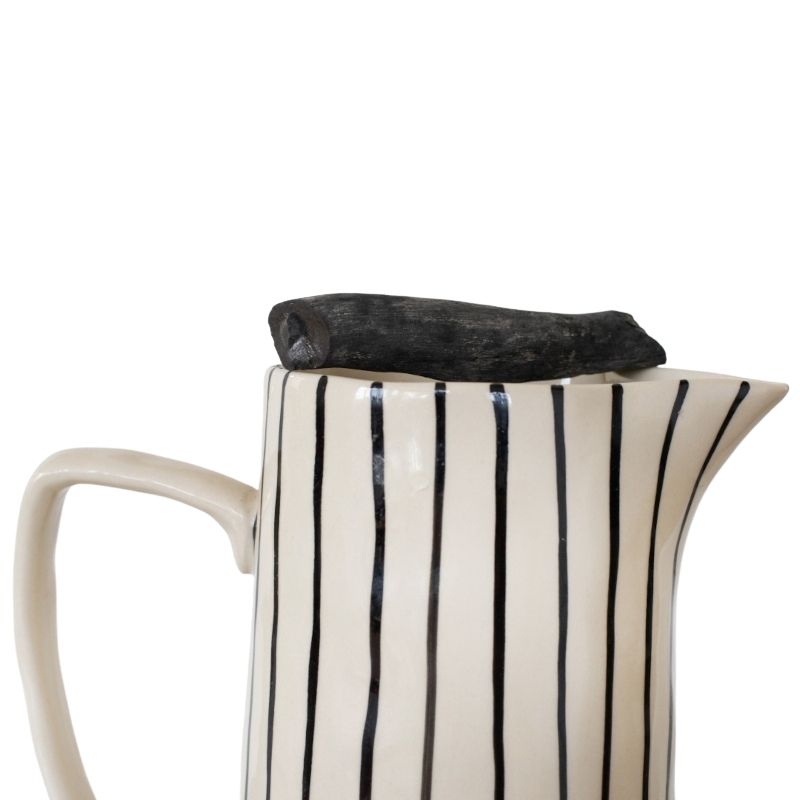
23. Can ceramic beads and binchotan charcoal be combined in the same jug?
Yes, without any problem. It is even worthwhile. The effect of ceramic beads and binchotan charcoal are complementary. One acts directly on the water molecules while the other acts as a mechanical filter by fixing the impurities.
You will simply have to adjust the dosage to suit you.
24. Can you mix grey and pink ceramic beads in a carafe?
Yes, the pink ceramic beads, as mentioned above, act by adsorption, i.e. they fix the molecules (a bit like binchotan charcoal). The grey and pink ceramic beads will therefore act in concert, in synergy.
If you do so, remember to take into account the different life spans of these two types of ceramic beads. Do not keep pink beads saturated with impurities in the decanter, remember to renew them after a few months, without changing the grey ceramic beads.
25. Are ceramic beads compatible with a stainless steel bottle?
Yes, without any contraindication. Ceramic beads are compatible with all types of containers, including stainless steel and glass, of course.
26. Can ceramic beads be put in water bottles with gas (soda stream type)?
A priori, nothing prevents you from putting ceramic beads in bottles of carbonated water. However, Chamarrel® recommends that you do not use ceramic beads when adding gas, which would not be suitable for pink ceramic beads and would certainly accelerate the mechanical wear of grey ceramic beads. But it's up to you, depending on the recommendations of your machine manufacturer.
It would be just as simple and less risky to add gas to tap water that has been resting in a carafe with ceramic beads. The result will be the same and the risk will be zero.
27. 27. How long do ceramic beads have to remain in the carafe to be effective?
When first used, it is recommended to let the water stand for 30 minutes in order to fully benefit from the action of the ceramic beads.
Recommendation: provide at least 2 to 3 carafes (depending on the size of the household) with ceramic beads so that you always have invigorating water available.
28. 28. Can the ceramic beads remain in the carafe or flask at all times?
Of course, it is recommended, that's what they are made for. Add water regularly, they love to stay in contact with it.
29. Kettle or coffee maker: how many ceramic beads to use?
Recommended quantity: 12 to 25 ceramic beads.
Insert the ceramic beads into the water tank of the coffee maker or kettle. You will quickly notice a drastic reduction in limescale deposits.
Caution: Do not use pink ceramic beads for this purpose, they may disintegrate quickly and become unusable.
30. Dishwasher: how many ceramic beads to use?
Recommended quantity: 12 to 24 ceramic beads depending on the size of the dishwasher.
Why use them in the dishwasher? You will be able to reduce the amount of dishwashing liquid you need to use. Even so, your dishes and cutlery will be beautifully shiny. As well as improving the washing and rinsing power of tap water, ceramic beads help with the routine maintenance of the dishwasher by significantly reducing limescale build-up and the damage it causes.
Caution: Place insulated ceramic beads (cloth bag) in the cutlery basket.
31. 31. Washing machine: how many ceramic beads to use?
Recommended quantity: 50 ceramic beads.
Less limescale build-up. Increased washing power and reduced quantity of detergent.
Precautions: Wrap the EM ceramic beads in a cloth bag, sock, or knotted flannel so that they can take part in the washing process and be reused in a future cycle.
32. Bathtub: how to enjoy the benefits of ceramic beads
Recommended quantity: 60 classic beads, or the special bath figurine, which has a suction cup and is specially adapted for this purpose.
The water in your bath will be softer and your skin will thank you.
When bathing, simply put the ceramic beads directly into the bath water or into a flannel.
33. Toilet flushing: how many ceramic beads should I use?
Recommended quantity: 1 mega ceramic bead or a handful of conventional ceramic beads to be placed in the toilet flush tank.
The use of ceramic beads in the toilet cistern will help reduce scale deposits in the bowl by avoiding the use of chemical disinfectant and descaling capsules.
34. 34. Sprinkling water: how many ceramic beads to use?
Recommended quantity: 20 to 40 ceramic beads per 10 litres. Place them in the watering can.
Plants feel very comfortable when treated with water containing EM ceramic beads. They are very hardy, flower and produce fruit regularly.
35. 35. Fruit and vegetables: how many ceramic beads to use?
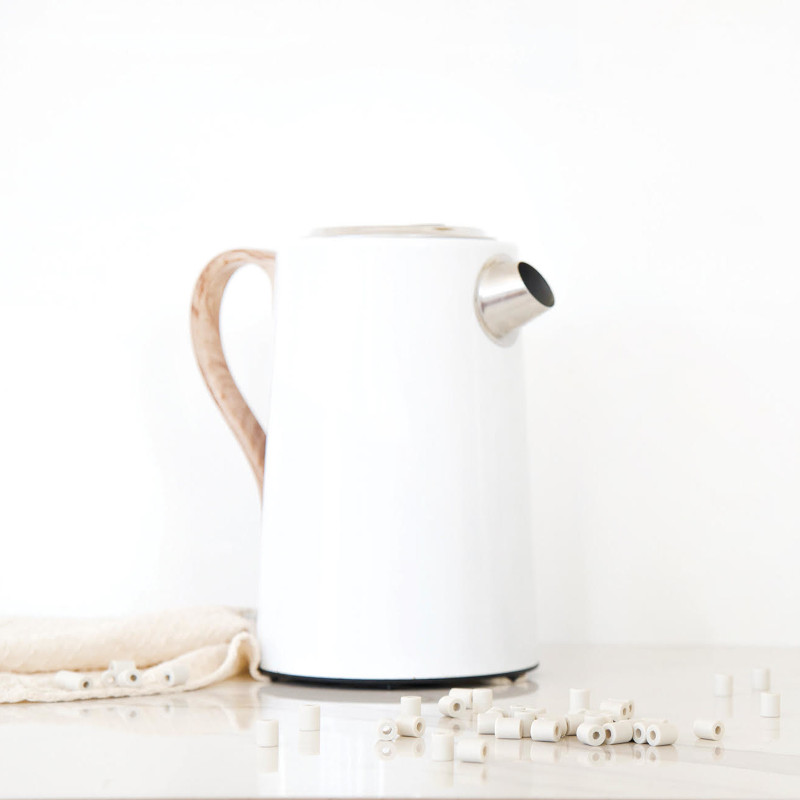
Recommended amount: About ten ceramic beads. Put a few ceramic beads in the wash water and leave for 10 minutes. Ceramic beads are also recommended for longer storage and better freshness by delaying rotting. Even in the case of already cleaned vegetables, you can put a few ceramic beads in the container or bag and even place it in the refrigerator.
36. 36. Vases and cut flowers: what dosage?
Recommended amount: A few ceramic beads, depending on the size of the vase and the amount of water it contains. Put a few ceramic beads in the water of the vase and leave them permanently at the bottom of the vase. Ceramic beads delay oxidation and invigorate the water, so you can enjoy your cut flowers much longer. To your bouquets!
37. Collars for dogs and pets: how many ceramic beads to use?
Recommended quantity: The quantity varies according to the size of your pet's neck. The weight of the ceramic beads should not weigh too heavily on his neck. Depending on the size of your pet, you can use between 10 and 20 beads.
Ceramic beads can be used on a collar to control and prevent ticks.
Of course, the above uses are not exhaustive and you can use ceramic beads in many other ways at home or in the garden.
Will you choose the ecological impact of ceramic beads? That's up to you. If so, they are available in bulk and retail on our site, but also in any good bulk and zero waste grocery shop.
If you have any further questions about this alternative, please do not hesitate to ask. We will do our best to answer them as soon as possible.
CERAMIC BEADS: WHY AND HOW TO ADOPT THIS ECOLOGICAL SOLUTION ?